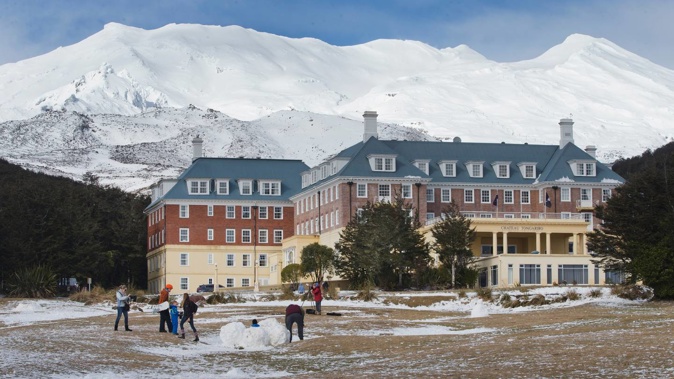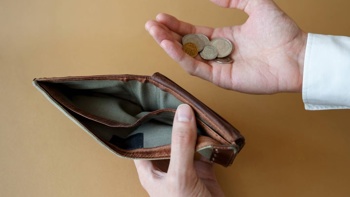
A “building condition appraisal” of the shuttered and rundown Chateau Tongariro Hotel has found that some $5.4m of repairs were “urgent” and “required” when it was handed back to the Department of Conservation in March this year.
The cost and extent of the needed repair may now be shaping into a legal dispute between the Crown and the hotelier and former lessee of the site, Kah New Zealand, owned by a Malaysian-based parent. A key unresolved question is: who will pay?The terms of Kah’s long-term lease – which expired in March – requires that it return to the Crown the site and buildings in “good repair and condition” or, under certain circumstances, it must demolish and remove the buildings from the site altogether. The Department of Conservation (DoC) released the building condition appraisal to ZB Plus under the provisions of the Official Information Act (OIA), but it withheld a second document: “Schedule of Reinstatement and Wants of Repair – Chateau Tongariro”.Mike Tully, deputy director-general organisation support at the department, said this second document was produced: “for the purpose of an apprehended legal proceeding.” It was withheld in full to retain legal professional privilege.Both reports were produced for DoC by property consultants Prendos. Tully declined to answer ZB Plus’ questions about any possible court action.Kah has not yet responded to questions about the Chateau’s state of repair and any possible court action, put to it by ZB Plus.On March 9, DoC took over responsibility for the Chateau from Kah, following protracted and failed negotiations to renew the company’s lease on the site.
At the time, the company blamed the business closure on the seismic strengthening work the Chateau needs and business uncertainty resulting from the financial troubles of local skifields, Whakapapa and Tūroa. Kah was also dogged by staffing difficulties and was issued three improvement notices by WorkSafe last year.DoC owns the national park land on which the Chateau sits, however, Kah bought the Chateau buildings from the government-owned Tourist Hotel Corporation of New Zealand (THC) in 1991. At the time, THC also assigned Kah its 1990 DoC lease for the Chateau site.The fate of the Chateau – a Category 1 historic place listed by Heritage NZ – is uncertain, and it contains within it the vexed question of just how much public money should be spent preserving it.The repair estimate is another indication that the cost of keeping the historic but seismically unsound building, perched on the side of an active volcano, is likely to require very considerable taxpayer funding.
 The immediate repair work required is in addition to the significant structural strengthening the building needs to meet legal standards. Architecture and engineering professionals have advised the Herald that, though it remains very uncertain, the cost of the seismic strengthening and renovation could easily top $100m, especially given the Heritage listing, which carries additional responsibilities for consultation, more onerous local council consenting requirements, and the expectation that the building’s heritage character be preserved.Tully said DoC has not yet estimated the cost of the seismic stengthening work required.It is possible a non-government operator will lease the building and share the cost of remediation with the Crown, or foot the bill itself, but given the anticipated cost it appears unlikely.A spokesperson for National Party deputy leader Nicola Willis said the party is not ready to consider questions related to the future of the Chateau given that it has not yet formed a Government.A detailed seismic report on the building, produced by engineering firm WSP earlier this year, found the main building, which dates to 1929, meets just 15 per cent of new building standards (NBS) and it has received an “E” grade, representing a “very high risk” to occupants in the event of an earthquake. Technically, the strengthening doesn’t need to be complete for several decades. But even if DoC could find a new tenant without first undertaking strengthening, it’s very unlikely it would countenance the risk.Taxpayers already paying
The immediate repair work required is in addition to the significant structural strengthening the building needs to meet legal standards. Architecture and engineering professionals have advised the Herald that, though it remains very uncertain, the cost of the seismic strengthening and renovation could easily top $100m, especially given the Heritage listing, which carries additional responsibilities for consultation, more onerous local council consenting requirements, and the expectation that the building’s heritage character be preserved.Tully said DoC has not yet estimated the cost of the seismic stengthening work required.It is possible a non-government operator will lease the building and share the cost of remediation with the Crown, or foot the bill itself, but given the anticipated cost it appears unlikely.A spokesperson for National Party deputy leader Nicola Willis said the party is not ready to consider questions related to the future of the Chateau given that it has not yet formed a Government.A detailed seismic report on the building, produced by engineering firm WSP earlier this year, found the main building, which dates to 1929, meets just 15 per cent of new building standards (NBS) and it has received an “E” grade, representing a “very high risk” to occupants in the event of an earthquake. Technically, the strengthening doesn’t need to be complete for several decades. But even if DoC could find a new tenant without first undertaking strengthening, it’s very unlikely it would countenance the risk.Taxpayers already paying
The complicated ownership of the Chateau means that taxpayers are currently paying for the ongoing upkeep and maintenance of the disused hotel and a sprawling series of several dozen ancilliary buildings.Under the OIA, DoC disclosed that this running and maintenance expense is roughly $51,000 per month; it includes the likes of on-site security, maintenance, rates, electricity and insurance. The needed repairs cited in the report appear to represent an additional cost.Furthermore, it’s understood that the additional cost to DoC of operating common facilities such as water treatment for the nearby Whakapapa Village, previously paid for by the Chateau’s “community services fees”, amounts to an additional $130,000 per month since March.Repair costs part of ongoing lease termination negotiations
DoC has been in lease termination negotiations with Kah since March, but these have been complicated by several conditions of the contract. Any successor lessee of the buildings will owe Kah for their value (to be determined by appointed valuers).In addition, the lease states that the buildings must be returned in good repair and condition, otherwise the value should be diminished commensurate with any deficiency.The lease stipulates that any new lessee must pay Kah for the value of the buildings, however, documents released by DoC under the OIA note that the department has considered paying out Kah for the buildings in advance of any new lessee.
Several reasons were outlined for taking this approach. The expense of remediating the Chateau likely means there is only a very dim chance of leasing the building again in the short to medium term. And, in addition, the lease contains the complicating provision that no new lessee can be offered terms more favourable than those enjoyed by Kah.The lease also contains a provision for the demolition and removal of the buildings, and for the cost to be borne by Kah. If DoC were to decide “not to grant a new Lease on the site” and its management plans allowed it, then it could give notice to, “the lessee to remove all Improvements [buildings] from the land in which case the Lessee shall pull down and remove all Improvements in a workmanlike manner so as not to cause any damage to the Land and to leave the land in clean and tidy condition.”In such circumstances, the lease requires DoC to provide a 5-year notice period to Kah.A DoC spokesperson declined to provide any detail on lease termination negotiations. He said they are ongoing. How Kah came to buy the Chateau
A 1991 sale and purchase agreement – withheld by DoC on the grounds of commercial sensitivity but released by Land Information New Zealand – shows that THC sold the Chateau buildings and the going concern hotel business to KAH.The THC Chateau Hotel, as it was called in the document, sold for $4.5m. A breakdown of this figure listed: $0.5m for goodwill, $3.5m for buildings, and $0.5m for plant and equipment. THC’s 30-year lease for the land was also transferred to Kah.Immediate repairs neededMuch of the immediate repair work recommended by Prendos relates to the Chateau’s roof – including pitched areas of metal sheeting and further flat areas – variously described as: “inadequately pitched”, “leaking”, “corroding”, “torn” and covered by “deteriorating waterproof membranes”.The report also indicates that immediate and near-term work should be performed on significant areas of the building’s cladding, especially its painted maisonry and polystyrene cladding, known to be related to problems of water ingress. Both the dilapidated roof and areas of cladding are responsible for wet and decaying timber framing, particularly roof timber. The report says that all of the work is required to prevent further deterioration.“The building is suffering from a lack of repair and maintenance over a prolonged period of time and as such is in a poor state of repair and has considerable deferred maintenance works required. There are water ingress issues to a number of areas. The building requires considerable investment to bring it into a state of repair…” the Prendos report concluded.It recommended that immediate repairs and maintenance worth $1m be urgently undertaken in the current year, and thereafter, between 2024 and 2027, a further $4.4m of work should be tackled.Tully said the repair work has not started.
Take your Radio, Podcasts and Music with you









